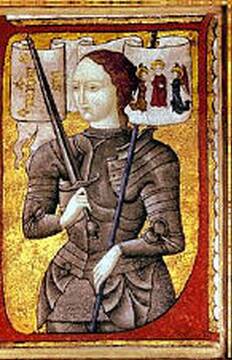 |
 |
 |
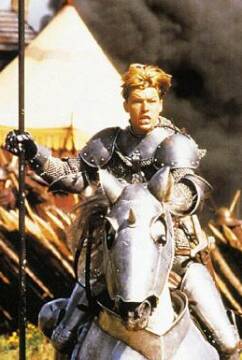 |
| Joan of Arc |
Ingrid Bergman |
Leelee Sobieski |
Milla Jovovich |
“Art imitating Arc?”
Isn’t it always the way. You wait six hundred years for a bio-pic, then two come along at once. Though actually, France’s patron saint has been the subject of films since the very earliest days of cinema – George Melies made a 12-scene reconstruction of her life in 1900 – but for no readily apparent reason, 1999 saw both a feature and a TV miniseries covering the topic. Before we discuss those, and some other related works, some background is probably wise, as when ever you deal with movies based on historical events. Real life is rarely cinematic, and any conflict is liable to leave factual accuracy in the dirt, going “Did anyone get the number of that truck?” So, here is a potted biography of the Maid of Orleans
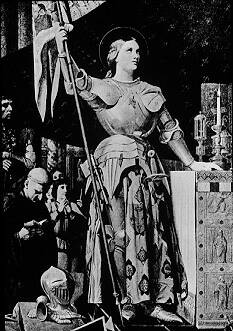 Born in the French province of Champagne in 1412, to a peasant farmer, Joan (or Jeanne – I’ll largely stick to the Anglicization) never learned to read or write, but was regarded by her contemporaries as a highly pious child. It was at the age of 13 that she first heard voices, but it took several years before they convinced her to leave home and help the French king, who was engaged in a battle to liberate the country from England. She presented herself to the local commander, who was skeptical at first, but was eventually convinced after Joan reported news of an English defeat before official confirmation arrived. Joan, clad in male attire to protect her modesty, travelled to see the king, and convinced him of the legitimacy of his claim to the throne, despite a faction of the court strongly opposing her influence. Her faith, simplicity and honesty won the day, and she acquired her sword, found buried behind an altar, in the exact spot she said it would be.
Born in the French province of Champagne in 1412, to a peasant farmer, Joan (or Jeanne – I’ll largely stick to the Anglicization) never learned to read or write, but was regarded by her contemporaries as a highly pious child. It was at the age of 13 that she first heard voices, but it took several years before they convinced her to leave home and help the French king, who was engaged in a battle to liberate the country from England. She presented herself to the local commander, who was skeptical at first, but was eventually convinced after Joan reported news of an English defeat before official confirmation arrived. Joan, clad in male attire to protect her modesty, travelled to see the king, and convinced him of the legitimacy of his claim to the throne, despite a faction of the court strongly opposing her influence. Her faith, simplicity and honesty won the day, and she acquired her sword, found buried behind an altar, in the exact spot she said it would be.
Although she did not engage in actual combat, her presence in the thick of battle acted as a unifying and galvanising force to the French, and she also imposed a pious attitude among her soldiers (no mean task, given they included the infamous Giles de Rais!), for example, driving away the camp whores. Joan’s soldiers raised the siege of Orleans, despite her being shot in the shoulder by an arrow, and subsequent successes led to the coronation of their king in July 1429. Had she gone home at this point, as she wanted to, her life would undoubtedly have been longer and happier. Instead, she continued her efforts to free her nation, and was injured again during an abortive assault on Paris, this time in the thigh. The following May, she was captured by John of Luxembourg, who sold her to the English. Charged with heresy, Joan continued to make a good impression, eventually causing the case to be held in camera.
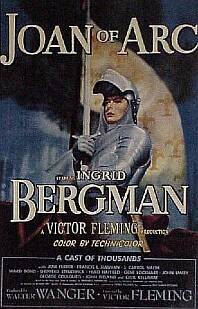 This was nothing more than a show trial, despite the efforts of those in charge to find support: according to biographer Jules Michelet, one jurist said “that everything about the trial was wrong; that it failed to respect the proper forms; that the assessors were not free; that the sessions were held in secrecy; that the accused…could not be expected to argue with learned doctors” and finished by declaring that it “was a trial to impugn the honour of the prince whose cause this girl is supporting; you should frankly say so.” Perhaps wisely, the holder of these opinions opted to leave France immediately for the safety of Rome.
This was nothing more than a show trial, despite the efforts of those in charge to find support: according to biographer Jules Michelet, one jurist said “that everything about the trial was wrong; that it failed to respect the proper forms; that the assessors were not free; that the sessions were held in secrecy; that the accused…could not be expected to argue with learned doctors” and finished by declaring that it “was a trial to impugn the honour of the prince whose cause this girl is supporting; you should frankly say so.” Perhaps wisely, the holder of these opinions opted to leave France immediately for the safety of Rome.
Inevitably, her visions were declared diabolical in nature, and she was told to recant or face the stake. Initially, she refused, but faced with imminent death, her courage understandably failed and she gave in. Her death sentence was suspended, to the chagrin of the English, who wanted her disposed of permanently. However, shortly afterwards, she resumed her wearing of male clothes – perhaps to prevent her guards from raping her, or because her normal attire was taken away. This was sufficient to have her condemned as a relapsed heretic; she was burned at the stake on May 30th, 1431. Joan was just nineteen years old. Twenty-four years later, however, a new trial overturned the verdict (albeit rather too late), beginning the process of rehabilitation which would conclude with her canonisation in 1920.
So much for the historical record. What of these subsequent productions telling her story? Are they accurate to the facts? And, perhaps more importantly, do they work as entertainment?
Joan the Woman
By
Jim McLennan
★★★½
“The first second* action heroine?”
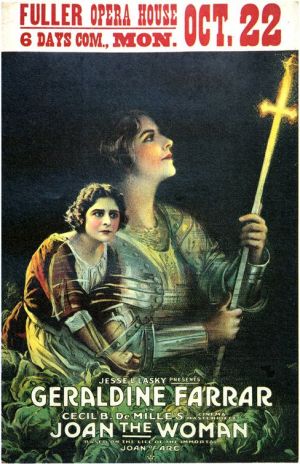 I don’t watch many silent films: it’s such an entirely different experience, obviously, much less driven by dialogue and more by gestures, leading to a style that can look extremely over-theatrical to the modern viewer. My efforts to enjoy the likes of Nosferatu, for example, have usually ended in my providing an accompaniment of snoring, to be honest. This was much better. Despite a running time of over two hours, this 1916 DeMille epic successfully held my interest, as it told the story of Joan of Arc. The framing device uses the then-contemporary World War I, and an English soldier (Reid) finds Joan’s sword in the trenches, the night before a dangerous mission [Interesting how the English are the enemy in the back-story, but the good guys “now” – at the time of release, America was still several months from entering the war, on the British side]. He then experiences a flashback vision, taking him to medieval France, where he is an English soldier saved by Joan (Farrar) in her milkmaid days. We follow her for the story you know, becoming the inspiration for the French army to defeat the English, before her capture, trial for heresy and – I trust I’m not spoiling this – burning at the stake.
I don’t watch many silent films: it’s such an entirely different experience, obviously, much less driven by dialogue and more by gestures, leading to a style that can look extremely over-theatrical to the modern viewer. My efforts to enjoy the likes of Nosferatu, for example, have usually ended in my providing an accompaniment of snoring, to be honest. This was much better. Despite a running time of over two hours, this 1916 DeMille epic successfully held my interest, as it told the story of Joan of Arc. The framing device uses the then-contemporary World War I, and an English soldier (Reid) finds Joan’s sword in the trenches, the night before a dangerous mission [Interesting how the English are the enemy in the back-story, but the good guys “now” – at the time of release, America was still several months from entering the war, on the British side]. He then experiences a flashback vision, taking him to medieval France, where he is an English soldier saved by Joan (Farrar) in her milkmaid days. We follow her for the story you know, becoming the inspiration for the French army to defeat the English, before her capture, trial for heresy and – I trust I’m not spoiling this – burning at the stake.
Now, don’t expect Joan to go hand-to-hand with the English army here. Still, she’s no nominal figurehead, instead leading her forces from the absolute front, as they break the siege at Orleans. She’s first into the breach, waving the standard to encourage them on, until she takes an arrow in the shoulder. Certainly, there’s no denying her heroic credentials: she’s portrayed as brave and committed to doing the right thing. The film probably does a better job of establishing her as a credible leader than the Luc Besson adaptation: you can see why people would follow her, and it plays the religious elements relatively soft. And the action sequences demonstrate why DeMille’s reputation for epics is well-deserved, with the battle for Orleans impressively-staged, capturing the chaos of war, without needing to resort the the blender-style editing or shaky camerawork, too often seen in modern war movies.
It’s a shame there isn’t more of that. Instead, after Orleans, the rest of her war campaign is covered in a caption, and the film is, understandably, less successful, when it comes to the more talky aspects of her life. In particular, Joan’s trial and incarceration becomes a lengthy sequence of meaningful stares and dramatic flailing. Still, I liked the way it all wrapped around, Joan’s story giving the soldier the courage to go on his mission, though the ending is more mournful than I expected. All told, for something approaching its one-hundredth birthday, this certainly didn’t feel like it, and DeMille deserves credit for laying some foundations for film-makers to come.
Dir: Cecil B. DeMille
Star: Geraldine Farrar, Wallace Reid, Raymond Hatton, Theodore Roberts
* = I’ve since discovered a 1915 Italian film, Filibus, which predates this. A review is here.
Joan Of Arc (1948)
By
Jim McLennan
★★
“Joan of Talk”
 This film’s origins as a stage play are painfully apparent, and you can also see why the distributor’s felt it needed to have 45 minutes cut out before it could be released, as frankly, it’s a bit of a bore. The battle to recapture Orleans is the only action of note here, even though that represented the start of the Maid’s campaign to restore France to its proper ruler (Ferrer), rather than the end. After that, this more or less skips forward to his coronation, then Joan’s capture, spending the rest of the movie – and there’s a lot of it – going through the trial, and the railroading of the heroine into, first throwing herself on the church’s mercy, then recanting her recantation and returning to wearing men’s clothes, thereby sealing her fate. There’s not much here which you won’t have seen before, if you’ve seen any of the other versions of the story, touching the usual bases from Joan’s revelations that she’s going to be the saviour of France, through her trip to see the Dauphin, and so on. It does downplay the “voices” aspect, especially early on, perhaps a wise move since it’s difficult to depict, without making her seem like a religious fruitcake.
This film’s origins as a stage play are painfully apparent, and you can also see why the distributor’s felt it needed to have 45 minutes cut out before it could be released, as frankly, it’s a bit of a bore. The battle to recapture Orleans is the only action of note here, even though that represented the start of the Maid’s campaign to restore France to its proper ruler (Ferrer), rather than the end. After that, this more or less skips forward to his coronation, then Joan’s capture, spending the rest of the movie – and there’s a lot of it – going through the trial, and the railroading of the heroine into, first throwing herself on the church’s mercy, then recanting her recantation and returning to wearing men’s clothes, thereby sealing her fate. There’s not much here which you won’t have seen before, if you’ve seen any of the other versions of the story, touching the usual bases from Joan’s revelations that she’s going to be the saviour of France, through her trip to see the Dauphin, and so on. It does downplay the “voices” aspect, especially early on, perhaps a wise move since it’s difficult to depict, without making her seem like a religious fruitcake.
The other problem I find is Bergman. It’s not so much her performance here, which is actually very good, and help hold the film up when things get particularly static: she hits her emotional marks well, and the Oscar nomination she received was not undeserved. However, she was solidly into her thirties by this point, probably close to twice the age of the actual Miss of Arc [hat-tip to Bill and Ted!]; there’s only so far make-up can go in taking years off someone. It does seem to have been a character to whom she related: she’s play the role again later, for Roberto Rossellini in Joan at the Stake, when she was nearly forty. The other problem is Bergman’s Scandinavian origins, which poke through her dialogue persistently, also damaging the illusion; it might have been fine in forties Hollywood, where one European accent was considered much the same as another, but now, it sounds too much Joan was a Swedish exchange student or au-pair – especially when she’s wearing her headsquare, and looks ready for a spot of light dusting.
But there’s no denying it looks the part, with production value seeping out of every frame – the Oscars this actually won, for cinematography and costume design, are hard to argue. However, there’s only so far this can take a film, along with Bergman glowing her way through her scenes, in such a way you could probably read a newspaper by her incandescence. That distance is considerably less than 145 minutes, and by the time this is over, you might find yourself guiltily cheering for her arrival at the stake, knowing this means the end is nigh.
Dir: Victor Fleming
Star: Ingrid Bergman, Francis L. Sullivan, José Ferrer, J. Carrol Naish
Saint Joan
By
Jim McLennan
★★
“Joan of Inaction”
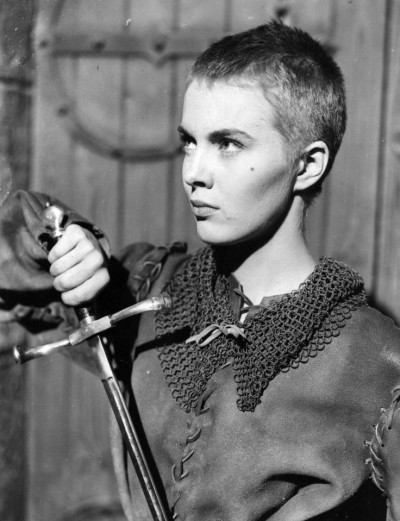 An adaptation by noted playwright Graham Green of George Bernard Shaw’s 1924 play, this is most famous for the extensive search undertaken by director Preminger to find the “right” Joan for the job, which involved testing over 18,000 candidates before settling on Seberg. whose only previous acting to that point had been in school plays. That’s in sharp contrast to the experience in the rest of the cast, which included Widmark as Charles, the Dauphin enthroned by Joan’s actions, and Gielgud as the Earl of Warwick, whose schemes lead to the heroine’s death at the stake. But what’s most notable here, in contrast to some of the other versions of the story we’ve written about, Preminger and Greene seem entirely disinterested in the process which brought the Dauphin to the crown. We see Joan’s rise to command, but the film then skips over everything from her approaching the fortress of Orleans, to the coronation of King Charles. In other words: the fun bits.
An adaptation by noted playwright Graham Green of George Bernard Shaw’s 1924 play, this is most famous for the extensive search undertaken by director Preminger to find the “right” Joan for the job, which involved testing over 18,000 candidates before settling on Seberg. whose only previous acting to that point had been in school plays. That’s in sharp contrast to the experience in the rest of the cast, which included Widmark as Charles, the Dauphin enthroned by Joan’s actions, and Gielgud as the Earl of Warwick, whose schemes lead to the heroine’s death at the stake. But what’s most notable here, in contrast to some of the other versions of the story we’ve written about, Preminger and Greene seem entirely disinterested in the process which brought the Dauphin to the crown. We see Joan’s rise to command, but the film then skips over everything from her approaching the fortress of Orleans, to the coronation of King Charles. In other words: the fun bits.
The framing story has Joan as a specter, visiting the aged king, along with the ghost of the Earl and other participants in her life, such as the English soldier who took pity on Joan at the stake and gave her a makeshift cross to hold. The adaptation whacked out, it appears, close to half the running-time of the play, and one had to wonder whether it is any more faithful to the work’s spirit. For in the preface to his work, Shaw explicitly wrote, “Any book about Joan which begins by describing her as a beauty may be at once classed as a romance. Not one of Joan’s comrades, in village, court, or camp, even when they were straining themselves to please the king by praising her, ever claimed that she was pretty.” This is in sharp contrast to Seberg, who even after giving up her long feminine locks for the almost compulsory crew-cut, looks more like Audrey Hepburn’s tomboyish little sister than someone, in Shaw’s words, “unattractive sexually to a degree that seemed to [contemporary writers] miraculous.”
It’s not entirely without merit; some of Shaw’s text still retains its impact, such as Joan’s explanation of why the French are losing: “Our soldiers are always beaten because they are fighting only to save their skins; and the shortest way to save your skin is to run away. Our knights are thinking only of the money they will make in ransoms: it is not kill or be killed with them, but pay or be paid. But I will teach them all to fight that the will of God may be done in France; and then they will drive the poor goddams before them like sheep.” The sheer certainty in Joan’s mind that’s she’s right, and will accept no arguments to the contrary, is impressive. Unfortunately, it’s not enough to sustain the film overall, and you’re left without much insight into either the history, or the personalities who created it.
Dir: Otto Preminger
Star: Jean Seberg, Richard Widmark, Anton Walbrook, John Gielgud
The Messenger: the story of Joan of Arc
By
Jim McLennan
★★★
“Joan’s eminent originality was her common sense”
 This was the the very first sentence of Michelet’s classic biography, published in 1853, but you’d be hard pressed to recognise the same person in Besson’s portrayal. A more accurate summary of this Joan would be the line spoken to her as she languished in prison: “You didn’t see what was, Jeanne – you saw what you wanted to see…” Besson comes down firmly in the school of thought which has Joan as a mentally deranged religious loony. While this is a viable theory, it doesn’t work as played by Jovovich – all twitchy, rolling her eyes and staring off into the distance – since it becomes impossible to see why anyone would have followed her. Unless we assume the 14th century French population were entirely gullible, she should have spent her life quietly as some village’s idiot. This cripples the film irreperably, since we feel little or no sympathy for a heroine depicted as a frothing zealot.
This was the the very first sentence of Michelet’s classic biography, published in 1853, but you’d be hard pressed to recognise the same person in Besson’s portrayal. A more accurate summary of this Joan would be the line spoken to her as she languished in prison: “You didn’t see what was, Jeanne – you saw what you wanted to see…” Besson comes down firmly in the school of thought which has Joan as a mentally deranged religious loony. While this is a viable theory, it doesn’t work as played by Jovovich – all twitchy, rolling her eyes and staring off into the distance – since it becomes impossible to see why anyone would have followed her. Unless we assume the 14th century French population were entirely gullible, she should have spent her life quietly as some village’s idiot. This cripples the film irreperably, since we feel little or no sympathy for a heroine depicted as a frothing zealot.
Historically too, it gets off to a bad start – an entirely fabricated incident in which Joan sees her sister first killed, then raped by an English soldier. This provides a spurious ground for Joan to hate the invaders, when contemporary accounts tell of her concern being almost equal for both sides. Also made-up is her finding a sword in a field, and there is a sudden leap, with Joan arriving to an audience with the King – in truth, she talked her way up the hierarchy. A rather lurid scene (missing from the US theatrical release) where Joan’s virginity is verified, marks the end of a troubling first act. Once her campaign begins, though, the film improves drastically, with excellent (if somewhat implausible – did they really use something resembling helicopter rotors as weapons?) battle scenes, that are at once enthralling and grim. It’s understandable when they unhinge Joan’s sanity even more; another of the themes seems to be that her mission was really non-Christian, in that it led to the deaths of so many people. Something about “thou shalt not kill”, though given the bloody history of Christianity, singling her out seems somewhat unfair. Tcheky Karyo delivers a fine performance as the leader of Joan’s army, facing the difficult task of balancing her expectations, with prosaic things like, oh, not getting killed.
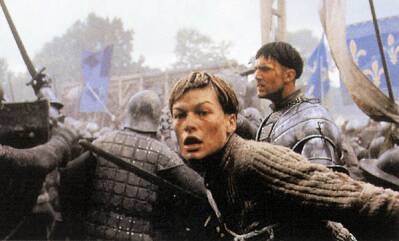 Joan’s capture, trial and execution are fairly close to the truth, though in reality, the King was less involved and more concerned for Joan than shown. It certainly is reasonable to suggest that a naive innocent such as Joan would have been used for political ends. Once she’d outlasted her usefulness – and with the king on the throne, she quickly became more a hindrance than a help – she would have needed to be disposed of. Must confess, I quite like the concept of Joan as a medieval version of Lee Harvey Oswald. Dustin Hoffman’s appearance as Joan’s conscience is another neat touch, and his sarcasm works well. Indeed, the film is one good performance from being excellent. The bad news is, it’s Jovovich who is the culprit (a messenger who deserves to be shot?), though Besson and co-writer Andrew Birkin perhaps warrant most of the criticism for twisting facts and characters in order to fit a predetermined goal. Their Joan is so far from the historical record, they’d have been better off placing their character in an entirely fictitious setting.
Joan’s capture, trial and execution are fairly close to the truth, though in reality, the King was less involved and more concerned for Joan than shown. It certainly is reasonable to suggest that a naive innocent such as Joan would have been used for political ends. Once she’d outlasted her usefulness – and with the king on the throne, she quickly became more a hindrance than a help – she would have needed to be disposed of. Must confess, I quite like the concept of Joan as a medieval version of Lee Harvey Oswald. Dustin Hoffman’s appearance as Joan’s conscience is another neat touch, and his sarcasm works well. Indeed, the film is one good performance from being excellent. The bad news is, it’s Jovovich who is the culprit (a messenger who deserves to be shot?), though Besson and co-writer Andrew Birkin perhaps warrant most of the criticism for twisting facts and characters in order to fit a predetermined goal. Their Joan is so far from the historical record, they’d have been better off placing their character in an entirely fictitious setting.
Dir: Luc Besson
Star: Milla Jovovich, John Malkovich, Faye Dunaway, Tcheky Karyo
Joan of Arc (1999)
By
Jim McLennan
★★★★

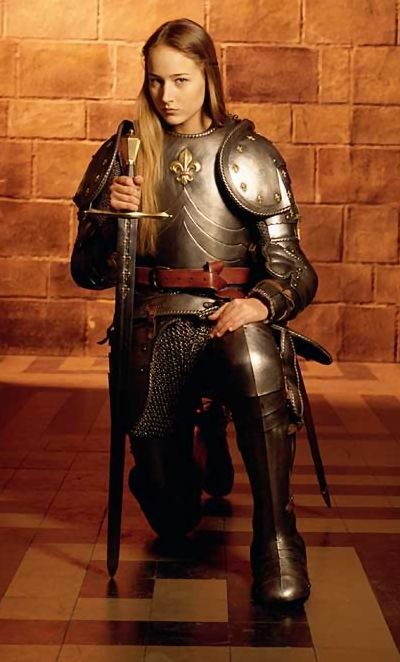 One problem with history is that viewers likely know how it ends: if you want to surprise them, why bother making a historical drama? Joan of Arc knows this, so starts with her burning at the stake. It’s a bit of a double-edged sword: it robs the climax of its striking power, yet acknowledges without doubt, that this is a tragedy. The theme of manipulation is again strong here, with Joan discarded after having outlived her usefulness, despite an odd character change in the second half, where she drifts for a jarring moment into petulant bitch mode. It’s almost as if the makers hinted at a megalomaniacal side, crazed by power, and her fatalistic approach to her capture rings false – probably because it is nowhere near the truth. There’s more fabrication early on, with Joan an unwanted daughter who sees a friend (blind, no less) killed by enemy soldiers – must she always be some kind of post-traumatic stress survivor?
One problem with history is that viewers likely know how it ends: if you want to surprise them, why bother making a historical drama? Joan of Arc knows this, so starts with her burning at the stake. It’s a bit of a double-edged sword: it robs the climax of its striking power, yet acknowledges without doubt, that this is a tragedy. The theme of manipulation is again strong here, with Joan discarded after having outlived her usefulness, despite an odd character change in the second half, where she drifts for a jarring moment into petulant bitch mode. It’s almost as if the makers hinted at a megalomaniacal side, crazed by power, and her fatalistic approach to her capture rings false – probably because it is nowhere near the truth. There’s more fabrication early on, with Joan an unwanted daughter who sees a friend (blind, no less) killed by enemy soldiers – must she always be some kind of post-traumatic stress survivor?
Once it hits its stride, however, there is rarely a wrong step, at least dramatically speaking – the French king again comes off as far more implicated in Joan’s death than evidence suggests. Neil Patrick Harris is convincing as Charles, who moves from self-doubt to certainty in his divine right to be king, then on to using that power against the one who put him there. Peter O’Toole too turns in a fine performance as Bishop Cauchon, though more facts are tampered with, allowing him to act as Charles’ spiritual advisor when he was actually always on the English/Burgundian side. That it’s a TV miniseries is apparent, with 15th century France populated by remarkably clear-skinned and straight-teethed people. There’s even hints of romance between Joan and her companion, Jean de Metz, which serves little purpose. The battle scenes, too, are all but bloodless – I wasn’t expecting the decapitations and arterial spurting seen in Besson’s film, but I didn’t really want the Middle Ages, sanitized for my protection. Even the guy dying of plague looks pretty good. [Chris noted a glaring continuity error at the end: on her way up to the stake, Joan is wearing shoes, but by the time she gets there, she’s barefoot!]
 However, the main difference between this and The Messenger is that Joan of Arc is convincing. Perhaps with the advantage of having extra time (the DVD of the miniseries runs 189 minutes), they make the effort to show her interacting with other characters, and Sobieski’s calm, complete assurance is a striking contrast to Jovovich. The viewer can see why people would believe her, and it naturally follows they will too – Sobieski’s Emmy nomination was entirely well-deserved. Despite playing fast and loose with the facts (another example: Joan’s brother was not killed in battle, but lived to see her trial verdict overturned), this strong central performance holds the film together and, with the aid of the other fine actors, makes it eminently watchable. It may not be historically accurate, but it does a fine job of explaining why her myth is still honoured in the third millennium, without coming down in one camp or the other regarding the source of her visions. There are few TV miniseries worth watching, and fewer still worth owning, but this one comes highly recommended.
However, the main difference between this and The Messenger is that Joan of Arc is convincing. Perhaps with the advantage of having extra time (the DVD of the miniseries runs 189 minutes), they make the effort to show her interacting with other characters, and Sobieski’s calm, complete assurance is a striking contrast to Jovovich. The viewer can see why people would believe her, and it naturally follows they will too – Sobieski’s Emmy nomination was entirely well-deserved. Despite playing fast and loose with the facts (another example: Joan’s brother was not killed in battle, but lived to see her trial verdict overturned), this strong central performance holds the film together and, with the aid of the other fine actors, makes it eminently watchable. It may not be historically accurate, but it does a fine job of explaining why her myth is still honoured in the third millennium, without coming down in one camp or the other regarding the source of her visions. There are few TV miniseries worth watching, and fewer still worth owning, but this one comes highly recommended.
Dir: Christian Duguay
Star: Leelee Sobieski, Neil Patrick Harris, Peter O’Toole, Chad Willett
 This was the the very first sentence of Michelet’s classic biography, published in 1853, but you’d be hard pressed to recognise the same person in Besson’s portrayal. A more accurate summary of this Joan would be the line spoken to her as she languished in prison: “You didn’t see what was, Jeanne – you saw what you wanted to see…” Besson comes down firmly in the school of thought which has Joan as a mentally deranged religious loony. While this is a viable theory, it doesn’t work as played by Jovovich – all twitchy, rolling her eyes and staring off into the distance – since it becomes impossible to see why anyone would have followed her. Unless we assume the 14th century French population were entirely gullible, she should have spent her life quietly as some village’s idiot. This cripples the film irreperably, since we feel little or no sympathy for a heroine depicted as a frothing zealot.
This was the the very first sentence of Michelet’s classic biography, published in 1853, but you’d be hard pressed to recognise the same person in Besson’s portrayal. A more accurate summary of this Joan would be the line spoken to her as she languished in prison: “You didn’t see what was, Jeanne – you saw what you wanted to see…” Besson comes down firmly in the school of thought which has Joan as a mentally deranged religious loony. While this is a viable theory, it doesn’t work as played by Jovovich – all twitchy, rolling her eyes and staring off into the distance – since it becomes impossible to see why anyone would have followed her. Unless we assume the 14th century French population were entirely gullible, she should have spent her life quietly as some village’s idiot. This cripples the film irreperably, since we feel little or no sympathy for a heroine depicted as a frothing zealot. Joan’s capture, trial and execution are fairly close to the truth, though in reality, the King was less involved and more concerned for Joan than shown. It certainly is reasonable to suggest that a naive innocent such as Joan would have been used for political ends. Once she’d outlasted her usefulness – and with the king on the throne, she quickly became more a hindrance than a help – she would have needed to be disposed of. Must confess, I quite like the concept of Joan as a medieval version of Lee Harvey Oswald. Dustin Hoffman’s appearance as Joan’s conscience is another neat touch, and his sarcasm works well. Indeed, the film is one good performance from being excellent. The bad news is, it’s Jovovich who is the culprit (a messenger who deserves to be shot?), though Besson and co-writer Andrew Birkin perhaps warrant most of the criticism for twisting facts and characters in order to fit a predetermined goal. Their Joan is so far from the historical record, they’d have been better off placing their character in an entirely fictitious setting.
Joan’s capture, trial and execution are fairly close to the truth, though in reality, the King was less involved and more concerned for Joan than shown. It certainly is reasonable to suggest that a naive innocent such as Joan would have been used for political ends. Once she’d outlasted her usefulness – and with the king on the throne, she quickly became more a hindrance than a help – she would have needed to be disposed of. Must confess, I quite like the concept of Joan as a medieval version of Lee Harvey Oswald. Dustin Hoffman’s appearance as Joan’s conscience is another neat touch, and his sarcasm works well. Indeed, the film is one good performance from being excellent. The bad news is, it’s Jovovich who is the culprit (a messenger who deserves to be shot?), though Besson and co-writer Andrew Birkin perhaps warrant most of the criticism for twisting facts and characters in order to fit a predetermined goal. Their Joan is so far from the historical record, they’d have been better off placing their character in an entirely fictitious setting.








 Born in the French province of Champagne in 1412, to a peasant farmer, Joan (or Jeanne – I’ll largely stick to the Anglicization) never learned to read or write, but was regarded by her contemporaries as a highly pious child. It was at the age of 13 that she first heard voices, but it took several years before they convinced her to leave home and help the French king, who was engaged in a battle to liberate the country from England. She presented herself to the local commander, who was skeptical at first, but was eventually convinced after Joan reported news of an English defeat before official confirmation arrived. Joan, clad in male attire to protect her modesty, travelled to see the king, and convinced him of the legitimacy of his claim to the throne, despite a faction of the court strongly opposing her influence. Her faith, simplicity and honesty won the day, and she acquired her sword, found buried behind an altar, in the exact spot she said it would be.
Born in the French province of Champagne in 1412, to a peasant farmer, Joan (or Jeanne – I’ll largely stick to the Anglicization) never learned to read or write, but was regarded by her contemporaries as a highly pious child. It was at the age of 13 that she first heard voices, but it took several years before they convinced her to leave home and help the French king, who was engaged in a battle to liberate the country from England. She presented herself to the local commander, who was skeptical at first, but was eventually convinced after Joan reported news of an English defeat before official confirmation arrived. Joan, clad in male attire to protect her modesty, travelled to see the king, and convinced him of the legitimacy of his claim to the throne, despite a faction of the court strongly opposing her influence. Her faith, simplicity and honesty won the day, and she acquired her sword, found buried behind an altar, in the exact spot she said it would be. This was nothing more than a show trial, despite the efforts of those in charge to find support: according to biographer Jules Michelet, one jurist said “that everything about the trial was wrong; that it failed to respect the proper forms; that the assessors were not free; that the sessions were held in secrecy; that the accused…could not be expected to argue with learned doctors” and finished by declaring that it “was a trial to impugn the honour of the prince whose cause this girl is supporting; you should frankly say so.” Perhaps wisely, the holder of these opinions opted to leave France immediately for the safety of Rome.
This was nothing more than a show trial, despite the efforts of those in charge to find support: according to biographer Jules Michelet, one jurist said “that everything about the trial was wrong; that it failed to respect the proper forms; that the assessors were not free; that the sessions were held in secrecy; that the accused…could not be expected to argue with learned doctors” and finished by declaring that it “was a trial to impugn the honour of the prince whose cause this girl is supporting; you should frankly say so.” Perhaps wisely, the holder of these opinions opted to leave France immediately for the safety of Rome. I don’t watch many silent films: it’s such an entirely different experience, obviously, much less driven by dialogue and more by gestures, leading to a style that can look extremely over-theatrical to the modern viewer. My efforts to enjoy the likes of Nosferatu, for example, have usually ended in my providing an accompaniment of snoring, to be honest. This was much better. Despite a running time of over two hours, this 1916 DeMille epic successfully held my interest, as it told the story of Joan of Arc. The framing device uses the then-contemporary World War I, and an English soldier (Reid) finds Joan’s sword in the trenches, the night before a dangerous mission [Interesting how the English are the enemy in the back-story, but the good guys “now” – at the time of release, America was still several months from entering the war, on the British side]. He then experiences a flashback vision, taking him to medieval France, where he is an English soldier saved by Joan (Farrar) in her milkmaid days. We follow her for the story you know, becoming the inspiration for the French army to defeat the English, before her capture, trial for heresy and – I trust I’m not spoiling this – burning at the stake.
I don’t watch many silent films: it’s such an entirely different experience, obviously, much less driven by dialogue and more by gestures, leading to a style that can look extremely over-theatrical to the modern viewer. My efforts to enjoy the likes of Nosferatu, for example, have usually ended in my providing an accompaniment of snoring, to be honest. This was much better. Despite a running time of over two hours, this 1916 DeMille epic successfully held my interest, as it told the story of Joan of Arc. The framing device uses the then-contemporary World War I, and an English soldier (Reid) finds Joan’s sword in the trenches, the night before a dangerous mission [Interesting how the English are the enemy in the back-story, but the good guys “now” – at the time of release, America was still several months from entering the war, on the British side]. He then experiences a flashback vision, taking him to medieval France, where he is an English soldier saved by Joan (Farrar) in her milkmaid days. We follow her for the story you know, becoming the inspiration for the French army to defeat the English, before her capture, trial for heresy and – I trust I’m not spoiling this – burning at the stake. This film’s origins as a stage play are painfully apparent, and you can also see why the distributor’s felt it needed to have 45 minutes cut out before it could be released, as frankly, it’s a bit of a bore. The battle to recapture Orleans is the only action of note here, even though that represented the start of the Maid’s campaign to restore France to its proper ruler (Ferrer), rather than the end. After that, this more or less skips forward to his coronation, then Joan’s capture, spending the rest of the movie – and there’s a lot of it – going through the trial, and the railroading of the heroine into, first throwing herself on the church’s mercy, then recanting her recantation and returning to wearing men’s clothes, thereby sealing her fate. There’s not much here which you won’t have seen before, if you’ve seen any of the other versions of the story, touching the usual bases from Joan’s revelations that she’s going to be the saviour of France, through her trip to see the Dauphin, and so on. It does downplay the “voices” aspect, especially early on, perhaps a wise move since it’s difficult to depict, without making her seem like a religious fruitcake.
This film’s origins as a stage play are painfully apparent, and you can also see why the distributor’s felt it needed to have 45 minutes cut out before it could be released, as frankly, it’s a bit of a bore. The battle to recapture Orleans is the only action of note here, even though that represented the start of the Maid’s campaign to restore France to its proper ruler (Ferrer), rather than the end. After that, this more or less skips forward to his coronation, then Joan’s capture, spending the rest of the movie – and there’s a lot of it – going through the trial, and the railroading of the heroine into, first throwing herself on the church’s mercy, then recanting her recantation and returning to wearing men’s clothes, thereby sealing her fate. There’s not much here which you won’t have seen before, if you’ve seen any of the other versions of the story, touching the usual bases from Joan’s revelations that she’s going to be the saviour of France, through her trip to see the Dauphin, and so on. It does downplay the “voices” aspect, especially early on, perhaps a wise move since it’s difficult to depict, without making her seem like a religious fruitcake.


 However, the main difference between this and The Messenger is that Joan of Arc is convincing. Perhaps with the advantage of having extra time (the DVD of the miniseries runs 189 minutes), they make the effort to show her interacting with other characters, and Sobieski’s calm, complete assurance is a striking contrast to Jovovich. The viewer can see why people would believe her, and it naturally follows they will too – Sobieski’s Emmy nomination was entirely well-deserved. Despite playing fast and loose with the facts (another example: Joan’s brother was not killed in battle, but lived to see her trial verdict overturned), this strong central performance holds the film together and, with the aid of the other fine actors, makes it eminently watchable. It may not be historically accurate, but it does a fine job of explaining why her myth is still honoured in the third millennium, without coming down in one camp or the other regarding the source of her visions. There are few TV miniseries worth watching, and fewer still worth owning, but this one comes highly recommended.
However, the main difference between this and The Messenger is that Joan of Arc is convincing. Perhaps with the advantage of having extra time (the DVD of the miniseries runs 189 minutes), they make the effort to show her interacting with other characters, and Sobieski’s calm, complete assurance is a striking contrast to Jovovich. The viewer can see why people would believe her, and it naturally follows they will too – Sobieski’s Emmy nomination was entirely well-deserved. Despite playing fast and loose with the facts (another example: Joan’s brother was not killed in battle, but lived to see her trial verdict overturned), this strong central performance holds the film together and, with the aid of the other fine actors, makes it eminently watchable. It may not be historically accurate, but it does a fine job of explaining why her myth is still honoured in the third millennium, without coming down in one camp or the other regarding the source of her visions. There are few TV miniseries worth watching, and fewer still worth owning, but this one comes highly recommended. The same source comic inspired Lady Snowblood, but plenty of original thought has also been put into this, set in an interesting alternate present, after 500 years of imposed isolation. A band of fighters, the Takemikazuchi, have been thrown out of work and now roam the country, killing for pay. One of their number, Yuki (Shaku), discovers their leader (Shimoda) killed her mother, and after confronting him, leaves. Except the group’s motto seems to be, “No one here gets out alive”… She finds shelter with Takashi (Ito) – except he is part of a rebel group with a similar philosophy, so a quiet, peaceful life is not on the cards for either of them.
The same source comic inspired Lady Snowblood, but plenty of original thought has also been put into this, set in an interesting alternate present, after 500 years of imposed isolation. A band of fighters, the Takemikazuchi, have been thrown out of work and now roam the country, killing for pay. One of their number, Yuki (Shaku), discovers their leader (Shimoda) killed her mother, and after confronting him, leaves. Except the group’s motto seems to be, “No one here gets out alive”… She finds shelter with Takashi (Ito) – except he is part of a rebel group with a similar philosophy, so a quiet, peaceful life is not on the cards for either of them. Any similarities to Buffy are purely coincidental – despite the fact that our heroine Sakuya (Ando), like the blond one, has a soft spot for what she’s supposed to be slaying. Here, she saves the child of her first demon victim, and raises him as her kid brother Taro, despite unnervingly rapid growth and green lump on his head. She takes him on the ultimate mission, travelling to the recently-erupted Mount Fuji, which is the hellmou…er, source of the demons, to face the Spider Queen.
Any similarities to Buffy are purely coincidental – despite the fact that our heroine Sakuya (Ando), like the blond one, has a soft spot for what she’s supposed to be slaying. Here, she saves the child of her first demon victim, and raises him as her kid brother Taro, despite unnervingly rapid growth and green lump on his head. She takes him on the ultimate mission, travelling to the recently-erupted Mount Fuji, which is the hellmou…er, source of the demons, to face the Spider Queen.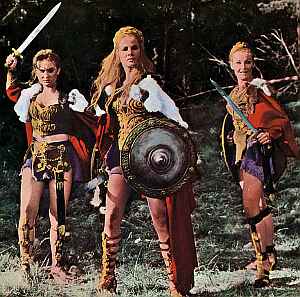 Hammer were best known for their horror movies, but tried virtually every genre save Westerns at one time or another. This Roman “epic” is loosely based on the life of Boadicea, who led a revolt against the Romans in the first century A.D. They get the name of her tribe right (the Iceni), and some basic facts, such as her suicide after capture, but change her name to Salina and sprinkle in some wild inaccuracies. Despite the title, there are no actual Vikings to be found, and we also get the Druids worshipping Zeus, a Greek god!
Hammer were best known for their horror movies, but tried virtually every genre save Westerns at one time or another. This Roman “epic” is loosely based on the life of Boadicea, who led a revolt against the Romans in the first century A.D. They get the name of her tribe right (the Iceni), and some basic facts, such as her suicide after capture, but change her name to Salina and sprinkle in some wild inaccuracies. Despite the title, there are no actual Vikings to be found, and we also get the Druids worshipping Zeus, a Greek god!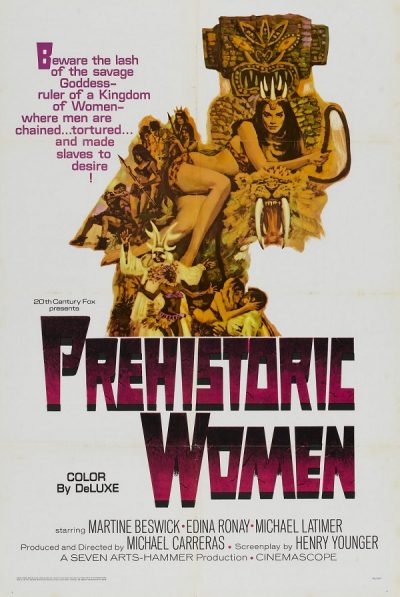
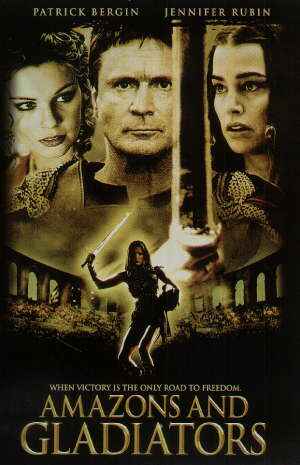 Benefiting from a slew of decent performances, A&G manages to surpass most of the competition and become a worthy entry in the “gladiatrix” sub-genre. This is perhaps because the cast have been hired either because they can act or because they can fight, while simultaneously not embarrassing themselves in the other department. Pity poor Hiltz, who is in virtually every scene, yet doesn’t even get her name on the cover.
Benefiting from a slew of decent performances, A&G manages to surpass most of the competition and become a worthy entry in the “gladiatrix” sub-genre. This is perhaps because the cast have been hired either because they can act or because they can fight, while simultaneously not embarrassing themselves in the other department. Pity poor Hiltz, who is in virtually every scene, yet doesn’t even get her name on the cover. Back in the mid-19th century, the West African kingdom of Dahomey had a singular army, led not by men, but by women. Even now, the “Amazons” of Dahomey represent an almost unique fighting force, the only confirmed case in history where the best soldiers in a male-led society were female. Their origins date back to rules forbidding men from being in the royal palace after dusk, leaving women to act as palace guards. When King Gezo took the throne in 1818, he was so impressed by the loyalty of his female protectors that he made them his army’s elite. So they remained, as many as 8,000 of them, until wiped out at the century’s end by vastly better-armed French colonial troops. Even then, they commanded respect. “These young women were far and away the best men in the Dahomeyan army, and woman to man were quite a match for any of us” – and this wasn’t any regular French soldier writing, but a member of the elite Foreign Legion.
Back in the mid-19th century, the West African kingdom of Dahomey had a singular army, led not by men, but by women. Even now, the “Amazons” of Dahomey represent an almost unique fighting force, the only confirmed case in history where the best soldiers in a male-led society were female. Their origins date back to rules forbidding men from being in the royal palace after dusk, leaving women to act as palace guards. When King Gezo took the throne in 1818, he was so impressed by the loyalty of his female protectors that he made them his army’s elite. So they remained, as many as 8,000 of them, until wiped out at the century’s end by vastly better-armed French colonial troops. Even then, they commanded respect. “These young women were far and away the best men in the Dahomeyan army, and woman to man were quite a match for any of us” – and this wasn’t any regular French soldier writing, but a member of the elite Foreign Legion.
 Arriving on a DVD of such poor quality, it has been shorn entirely of both opening and closing credits, but hey, I paid $4.99, so can’t really complain. The heroine – named Charlene for most of the film – helps her father run the White Lotus, a rebel group fighting the government in 18th-century China. They have to avoid capture, while simultaneously looking for her long-lost mother (who is in her turn, looking after them), and further diversion is caused by a subplot involving an evil landlord trying to marry a young girl against her will.
Arriving on a DVD of such poor quality, it has been shorn entirely of both opening and closing credits, but hey, I paid $4.99, so can’t really complain. The heroine – named Charlene for most of the film – helps her father run the White Lotus, a rebel group fighting the government in 18th-century China. They have to avoid capture, while simultaneously looking for her long-lost mother (who is in her turn, looking after them), and further diversion is caused by a subplot involving an evil landlord trying to marry a young girl against her will.